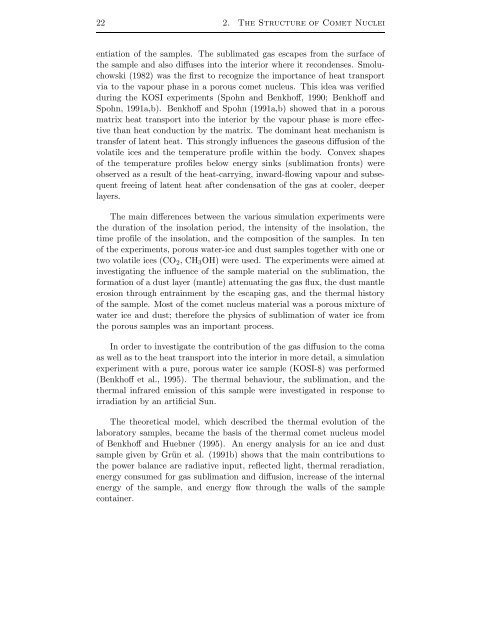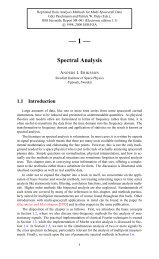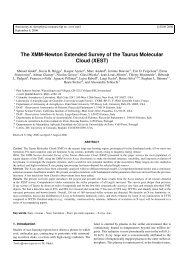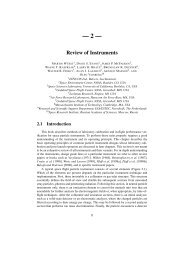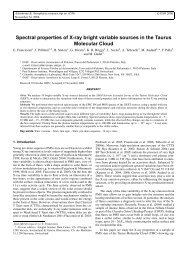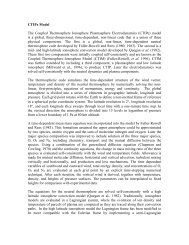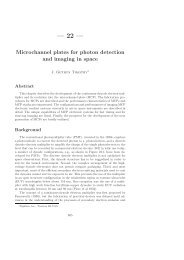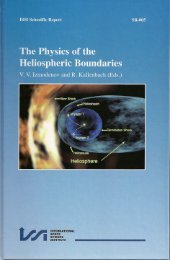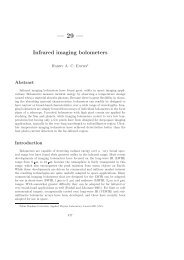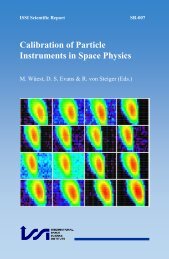Heat and Gas Diffusion in Comet Nuclei (pdf file 5.5 MB) - ISSI
Heat and Gas Diffusion in Comet Nuclei (pdf file 5.5 MB) - ISSI
Heat and Gas Diffusion in Comet Nuclei (pdf file 5.5 MB) - ISSI
Create successful ePaper yourself
Turn your PDF publications into a flip-book with our unique Google optimized e-Paper software.
22 2. The Structure of <strong>Comet</strong> <strong>Nuclei</strong><br />
entiation of the samples. The sublimated gas escapes from the surface of<br />
the sample <strong>and</strong> also diffuses <strong>in</strong>to the <strong>in</strong>terior where it recondenses. Smoluchowski<br />
(1982) was the first to recognize the importance of heat transport<br />
via to the vapour phase <strong>in</strong> a porous comet nucleus. This idea was verified<br />
dur<strong>in</strong>g the KOSI experiments (Spohn <strong>and</strong> Benkhoff, 1990; Benkhoff <strong>and</strong><br />
Spohn, 1991a,b). Benkhoff <strong>and</strong> Spohn (1991a,b) showed that <strong>in</strong> a porous<br />
matrix heat transport <strong>in</strong>to the <strong>in</strong>terior by the vapour phase is more effective<br />
than heat conduction by the matrix. The dom<strong>in</strong>ant heat mechanism is<br />
transfer of latent heat. This strongly <strong>in</strong>fluences the gaseous diffusion of the<br />
volatile ices <strong>and</strong> the temperature pro<strong>file</strong> with<strong>in</strong> the body. Convex shapes<br />
of the temperature pro<strong>file</strong>s below energy s<strong>in</strong>ks (sublimation fronts) were<br />
observed as a result of the heat-carry<strong>in</strong>g, <strong>in</strong>ward-flow<strong>in</strong>g vapour <strong>and</strong> subsequent<br />
free<strong>in</strong>g of latent heat after condensation of the gas at cooler, deeper<br />
layers.<br />
The ma<strong>in</strong> differences between the various simulation experiments were<br />
the duration of the <strong>in</strong>solation period, the <strong>in</strong>tensity of the <strong>in</strong>solation, the<br />
time pro<strong>file</strong> of the <strong>in</strong>solation, <strong>and</strong> the composition of the samples. In ten<br />
of the experiments, porous water-ice <strong>and</strong> dust samples together with one or<br />
two volatile ices (CO 2 , CH 3 OH) were used. The experiments were aimed at<br />
<strong>in</strong>vestigat<strong>in</strong>g the <strong>in</strong>fluence of the sample material on the sublimation, the<br />
formation of a dust layer (mantle) attenuat<strong>in</strong>g the gas flux, the dust mantle<br />
erosion through entra<strong>in</strong>ment by the escap<strong>in</strong>g gas, <strong>and</strong> the thermal history<br />
of the sample. Most of the comet nucleus material was a porous mixture of<br />
water ice <strong>and</strong> dust; therefore the physics of sublimation of water ice from<br />
the porous samples was an important process.<br />
In order to <strong>in</strong>vestigate the contribution of the gas diffusion to the coma<br />
as well as to the heat transport <strong>in</strong>to the <strong>in</strong>terior <strong>in</strong> more detail, a simulation<br />
experiment with a pure, porous water ice sample (KOSI-8) was performed<br />
(Benkhoff et al., 1995). The thermal behaviour, the sublimation, <strong>and</strong> the<br />
thermal <strong>in</strong>frared emission of this sample were <strong>in</strong>vestigated <strong>in</strong> response to<br />
irradiation by an artificial Sun.<br />
The theoretical model, which described the thermal evolution of the<br />
laboratory samples, became the basis of the thermal comet nucleus model<br />
of Benkhoff <strong>and</strong> Huebner (1995). An energy analysis for an ice <strong>and</strong> dust<br />
sample given by Grün et al. (1991b) shows that the ma<strong>in</strong> contributions to<br />
the power balance are radiative <strong>in</strong>put, reflected light, thermal reradiation,<br />
energy consumed for gas sublimation <strong>and</strong> diffusion, <strong>in</strong>crease of the <strong>in</strong>ternal<br />
energy of the sample, <strong>and</strong> energy flow through the walls of the sample<br />
conta<strong>in</strong>er.


